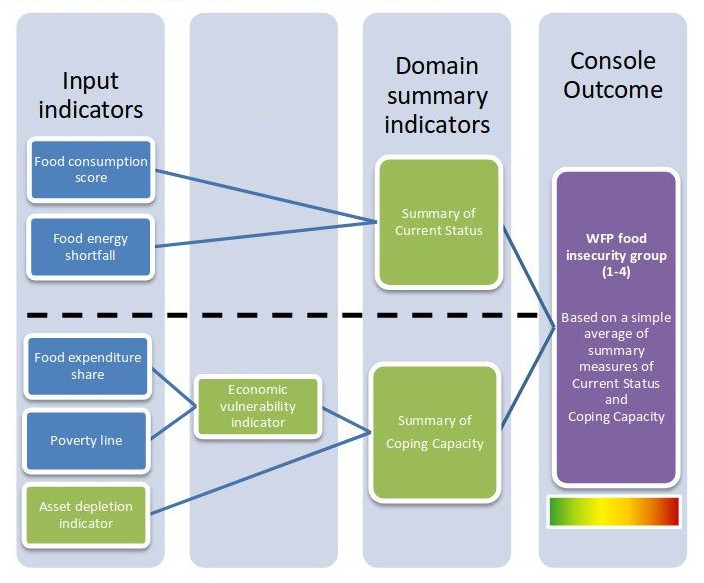How to calibrate protection vulnerability scoring?
V0.1 - Draft Version for peer review - as of 02 March 2021
1 Introduction
As soon as a humanitarian situation is moving away from the emergency phase, when a caseload goes beyond a certain size and both budget and resources are limited, scoring systems are required to inform decision numerous type of individual/household level type of assistance allocation (Cash-based Interventions, distribution of core relief items, professional training, micro-credit and other livelihood intervention but also community leaders training…). Scores uses numerical tools to rank order cases using data integrated into a single value that attempts to measure vulnerability risk. Scoring systems are designed for lowering the cost of serving people in needs and increasing the quality of both services and beneficiary satisfaction. For humanitarian assistance, vulnerability scores are the main concept to allocate individual assistance, in a similar way credit scoring can be used to increase financial inclusions by micro-credit organizations.
UNHCR/WFP Joint Guidance: Targeting of Assistance to Meet Basic Needs provides some elements on how to measure vulnerability from a protection angle:
UNHCR measures indicators of refugee well-being including health and nutrition status, water and sanitation, shel-ter, socio- economic poverty and protection vulnerabilities to guide assistance and solution strategies. Analysis of individual protection vulnerabilities is guided by the Specific Needs approach, which guides case management.[…] In addition UNHCR promotes the inclusion of refugees into National Poverty Assessments so as to be able to generate comparable data between refugees and host communities. Comparable socio-economic data is increasingly important to ascertain the level of assistance needed and to inform regional area-based development programs implemented by development and private sector partners together with National Governments as part of the Global Compact for Refugees
In addition the Basic Needs Approach in the Refugee Response outlines the need for a vulnerability framework and eligibility criteria:
Vulnerability analysis framework: The framework defines which households are vulnerable among the entire refugee population. Various socio-economic or sector models can be applied as tools to prioritize who is eligible to receive assistance. An efficient tool for predicting the welfare of all refugee households is econometric welfare modelling. An example can be found in the Vulnerability Assessment Framework in Jordan
Targeting: defining eligibility: Anchored in a rights-based approach, the identification and selection of individuals or households for appropriate assistance are based on multi-sectoral analysis of protection risks, wealth and food insecurity, the vulnerability framework and the identified needs. Information from monitoring is analysed and can be used to update targeting eligibility criteria and make other adjustments.
Though, those guidance do not provide details on how the calculation shall be made. For instance, how to combine the occurrence of multiple specific needs within the same household? How to reflect the interaction between socio-economic vulnerability and protection risks into a single score? As a result, each operation has a different approach to measure “vulnerability” in order to prioritize and target assistance. In the lack of specific guidance, there are risks that the resulting scores actually capture very different concepts or that adequate statistical treatments are not implemented. Beyond this, the lack of detailed guidance make it difficult to build technical capacity for operations data expert to build those measurement.
A standardized approach for the measurement of vulnerability, where the same formula could be applied universally and independently of the context is unlikely to be a robust approach. In the same joint guidance are referenced WFP Consolidated Approach for reporting indicators of food security, (CARI). Those provides details on how to build a composite indicator: the “Food Security Index”. In this approach, the theoretical model for the indicator is standardized while there’s also a process to customize it according to the context (aka a “calibration”).

CARI Food Security Index theoretical model
This document build on generic guidance on composite indicator development from the EU-joint Research Center on Composite Indicator and aims at providing a cookbook for field practitioners suggesting a similar approach than WFP, i.e. an harmonized theoretical model paired with a calibration process.
The following is a compilation of field findings in relation with the challenges related to protection vulnerability measurement. It is open for peer-review and contributions can be made in different ways:
- Open a discussion point
- Report a bug or suggest an improvement in the attached statistical code
- Fork the document and suggest additional elements with pull request
This document includes:
An executive summary for Senior Management to understand what they need to know in terms of high level concepts on vulnerability scoring
Contextual elements around scoring: why & when, how and risks
Hands-on tutorial for data experts on how to implement different approaches for calibration, using either expert opinions ( budget allocation, conjoint analysis or Analytic hierarchy process) or household survey data (Vulnerability proxy, Deprivation model or Item Response Theory) and to compare the results through a robustness and sensitivity analysis.
Explanation on how to use resulting household vulnerability scores in relation with targeting on one side (i.e. eligibility of different population segments for different type of interventions) and prioritization (i.e. final selection of beneficiaries for interventions that required to identify household, like Cash-based interventions at first)
All examples from this documents are build with a reproducible analysis approach, which implies for data expert on the field can simply adapt the scripts included in the documents to the context and data available in their own operations. Reference to related scripts are mentionned in each chapters